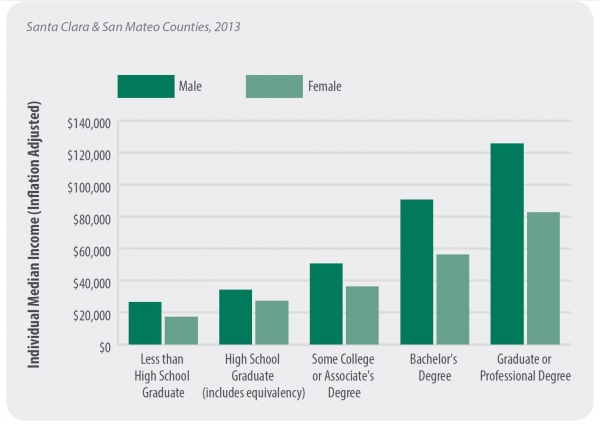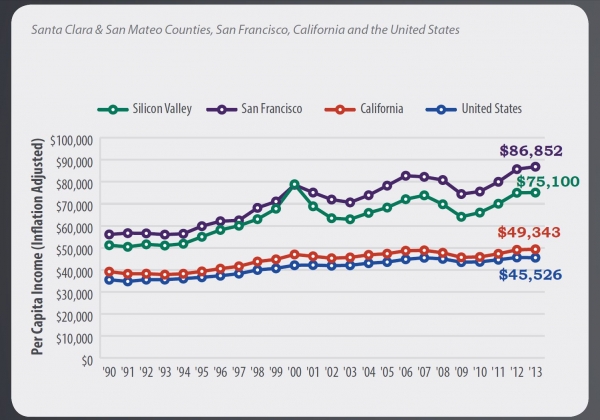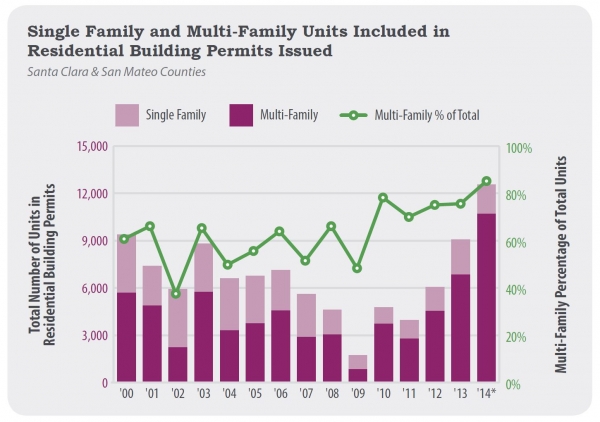Fueled by a sizzling tech sector, strong population growth and low unemployment, the Silicon Valley economy has grown rapidly since the doldrum days of the 2008 recession. So, too, have the income gaps between the region's wealthiest and poorest residents, between its men and women, and between its white and black residents, according to an annual report released Tuesday by the Joint Venture Silicon Valley.
The 2015 Silicon Valley Index presents a largely positive picture about the regional economy, with San Francisco's growing tech sector leading the charge. Venture capital investments spiked in 2014; the number of patents filed continues to rise; median household income and average wages both increased; housing prices are on the rise; and the job growth rate of 4.1 percent is the highest since 2000. These factors prompted Venture Silicon Valley CEO Russell Hancock to declare in his introduction to the Index that "the world's hottest regional economy keeps getting hotter" and to proclaim that this kind of growth is "a thing to celebrate, surely."
Yet the report also emphasizes the region's rising inequality, which pertains not just to different job sectors but also to gender and ethnicity. Black residents continue to lag behind other ethnic groups when it comes to income, and the gap between women and men also grew in 2013. Hancock noted that even as the Valley is "proliferating high-wage and low-wage jobs, we're steadily losing share in the middle."
"It's as if the economy has lost its spine, and this has important implications for the kind of community we become," Hancock said.
So what does a strong economy with a fractured spine look like? According to the new report, it means heaps of freshly minted but unevenly spread wealth. In many ways, the wealth is a cause to be celebrated. According to Hancock, Silicon Valley is "poised now to blow through all the employment, venture capital and patent records that were set during the crazy dot-com period, only this time we haven't spiked into it. We've arrived here through a steady five-year process of incremental growth, each year more impressive than the last."
The overall job numbers are particularly impressive. According to the Index, the total number of jobs in Silicon Valley has grown by 14.4 percent since 2010. In San Francisco, the job growth has been 15.3 percent, well above the state and national rates (8.7 percent and 6.4 percent, respectively). The city is also hogging a growing share of the state's venture capital, receiving 36 percent of the state's total, a huge increase over the 4 percent it secured in 2007. This is due in large part to major deals made in 2014 by San Francisco-based newcomers such as Uber, Dropbox, Lyft and AirBnB.
Yet the report also makes clear that the region's overall growth can't be attributed solely to tech. With the exception of "other manufacturing," which saw its employment numbers drop by 1.1 percent between the second quarter of 2013 and the second quarter of 2014, just about every sector has added jobs.
In the category "community infrastructure and services," Silicon Valley added 40,096 jobs between the second quarter of 2013 and the second quarter of 2014. In education, the region added 15,607 jobs; in "health care and social services" the number was 10,875; and in "innovation and information products and service," the figure was 18,445.
The rising economy also means more development, which in turns means more people and more traffic. Approved non-residential development, according to the report, was at a higher level in fiscal year 2013-14 than in any other year over the last decade with a net floor-area equivalent to 224 football fields. Housing construction has also been on the rise, particularly when it comes to multi-family developments. The recent growth has not, however, made up for the lack of building during the recession. With housing still at a premium, median home prices jumped by 7.5 percent from 2013 to 2014, reaching a median of $757,585.
This growth, however, is far from egalitarian. According to the report, the gender inequality gap remains large and is getting worse, particularly in Silicon Valley. Men in Silicon Valley earn considerably more than their female peers and the gap is "getting larger over time," the Index states.
The large gender gap applies to all education levels but is particularly pronounced among those with graduate or professional degrees. According to the Index, for residents with a bachelor's degree (220,000 men and 250,000 women), the individual median income in 2013 was 61 percent higher for men than for women. This is compared to a 20 percent differential in San Francisco, 41 percent in California and 48 percent in the United States. For those with a bachelor's degree, the gender gap in Silicon Valley increased by $5,000 between 2012 and 2013, rising from $29,090 to $34,233.
Per capita income in the region rose slightly between 2012 and 2013, going up by $89 to $75,100 in 2013 when adjusted for inflation. The increase applied to all racial and ethnic groups except black residents, according to the Index. White residents had the highest per capita income in 2013, while Hispanic and Latino residents earned the lowest, despite modest gains.
But according to the report, per capita incomes in 2013 for black and Hispanic residents in Silicon Valley (San Mateo and Santa Clara counties) were well below the pre-recession levels, down 20 percent and 12 percent, respectively, since 2007. During the same period, however, San Francisco saw an increase of 8.5 percent in per capita income for Hispanic and Latino residents, the report notes.
Furthermore, the report's good news about job growth is somewhat offset by the stagnant wages. In most industries, the wage growth in Silicon Valley has failed to keep up with inflation. The report notes that inflation-adjusted median wages for management, business, science and art occupations went down by 2.3 percent between 2010 and 2014. The greatest losses were in arts, design, entertainment, sports and media occupations, which saw a decrease of 10.6 percent since 2010. And despite a 6.2 percent increase in the number of jobs, service occupations in Silicon Valley's major metropolitan areas saw a decline of 9 percent in median wage since 2010, with personal-care occupations suffering a 14.4 percent decrease.





Comments
Old Mountain View
on Feb 4, 2015 at 4:06 pm
on Feb 4, 2015 at 4:06 pm
Having lived in Silicon Valley since the mid 60's and being part of the ups and downs, it's great to see the economy back on the right track. Having just returned from a trip to Bangkok and Tokyo, where heavy traffic and big crowds are the norm, I'm curious as to how we are going to resolve the traffic issue in the Bay Area. Bangkok has the tuk-tuk's and sky trains, and Japan has the most advanced transport system in the world.There has always been a lot of talk about improving the transit system in the Bay Area, however,it seems to be band aid plans rather than a total a plan that covers the whole Bay Area.
The thing that concerns me the most is the attitude of some of the young people in this valley. I have been in meetings, having discussions with individuals or just overheard conversations relating to the homeless,day workers and old people. Several people seem to believe that the "useless" people should be shipped out on trains and give place to the young innovators. Hitler spoke of that and took action. How sad that we are a nation not learning from history.
Monta Loma
on Feb 9, 2015 at 11:52 am
on Feb 9, 2015 at 11:52 am
Sick and tired of this pay inequality BS. You get paid what you are worth, and thank God in a Capitalistic society you can move to a better job, or get better skills to get a better job. You are not limited like in a socialistic Societies. This is what makes America Great. If everyone made the same, there would be no want to get ahead.